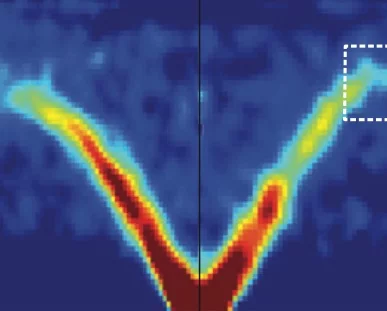Quantum magnets have occupied the fertile ground between many-body theory and low-temperature experiments on real materials since the early days of quantum mechanics. However, our understanding of even deceptively simple systems of interacting spin-1/2 particles is far from complete. The quantum square-lattice Heisenberg antiferromagnet, for example, exhibits a striking anomaly of hitherto unknown origin in its magnetic excitation spectrum. This quantum effect manifests itself for excitations propagating with the specific wavevector (π,0). We use polarized neutron spectroscopy to fully characterize the magnetic fluctuations in the metal-organic compound Cu(DCOO)2⋅4D2O, a known realization of the quantum square-lattice Heisenberg antiferromagnet model. Our experiments reveal an isotropic excitation continuum at the anomaly, which we analyse theoretically using Gutzwiller-projected trial wavefunctions. The excitation continuum is accounted for by the existence of spatially extended pairs of fractional S=1/2 quasiparticles, 2D analogues of 1D spinons. Away from the anomalous wavevector, these fractional excitations are bound and form conventional magnons. Our results establish the existence of fractional quasiparticles in the high-energy spectrum of a quasi-two-dimensional antiferromagnet, even in the absence of frustration.
- About the CentercloseAbout the Center
- Our Research
- Our User Facilities
- SINQ: Swiss Spallation Neutron Source
- SμS: Swiss Muon Source
- CHRISP: Swiss Research Infrastructure for Particle Physics
- Scientific Advisory Committees
- Publications
- Jobs & Education


